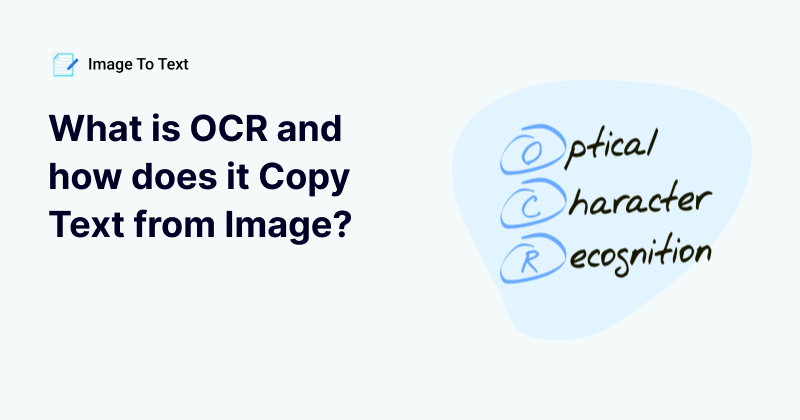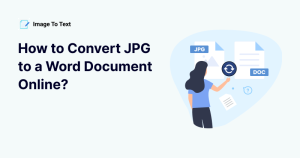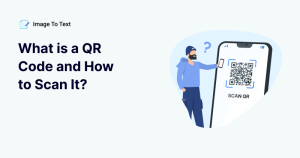What Is OCR And How Does It Copy Text From Image?
Optical Character Recognition is one of the most convenient technologies in modern academia. The usage of this device hasn't only made life easy for universities, colleges, and schools, but it has also helped businesses in various fields of life.
Imagine how easy it would be to put your bookshelf into a small USB drive. One of the leading reasons OCR has become a standard technology in academies and companies is its convenience and space-saving abilities.
But, how does it work? Moreover, what are the long-term implications of storing data on digital devices? Are there more ups than downs to it? Well, let us dig in and find the answers.
What Is OCR?
Back in 1920, Austrian engineer Gustav Tausacheck worked on the idea of a machine that could read characters. Up until that point, many people considered this a pipedream, with no future implications whatsoever.
By 1929, Gustav had attained a patent in Germany for his invention, the OCR machine. People also referred to it as the reading machine in the early days. This notion came from the practicality of this device, as reading is basically what it does.
However, the usage of OCR is way more complicated than it sounds. The device has become relatively shorter throughout the years, and you can find OCR pens attached to computers. These pens help you scan a document while inputting it into any digital device.
OCR uses optical lenses to scan documents, such as books, pamphlets, or other text types. This conversion of text from a physical medium to a digital copy is the precise operation of an optical character recognition device.
The optical lenses scan through documents and help the user scan through without manually inputting them into a digital device. This is one reason why OCR devices are a necessity of any institution with a lot of requirements in written work.
How Does It Create Documents?
Let's cut to the chase now; how exactly does it scan through documents? What are the key characteristics of an OCR device? Moreover, how does it scan physical text and convert it into soft copies or digital documents?
Remember that OCR is vastly different from a scanner, the kind you see attached to printers. The job of a scanner is to scan documents, while the job of an OCR device is to scan the documents letter-by-letter.
A scanner practically takes a picture of a document in an adequate environment. The scanner creates this environment by shutting the lid on the top of said document and pressing it on the optical scanning lenses.
In comparison, an OCR device scans through the document regardless of the light surrounding it. It doesn't take pictures of the said documents; instead, it recognizes each character then writes them into the digital device. Hence it's named optical character recognition.
These optical lenses are practically akin to the ones you can find on the bottom of your mouse or the ones in DVD or CD readers. Those optical lenses scan their respective objectives. For instance, a mouse's lens scans the surface to track your movement.
While the DVD or CD reader's optical is for scanning through the disk and looking for data burnt into it. On the contrary, the lenses in OCR devices browse through documents, looking for characters and formulating them into words.
Here's how it works through a document:
De-Skewing Alignments
If you scan a book through OCR, it needs to appear in a linear alignment within your desired device. OCR does this by de-skewing the alignment when scanning a document before turning characters into words.Zoning Paragraphs
The spacing and formation of your document come into play in this phase, as OCR recognizes the empty spaces on the page first. This process allows the device to scan through without worrying about page numbers, watermarks, or secondary text.Binarization: Colour Grading
If you scan a document, then it might appear blurry or distorted. OCR technology avoids it by enhancing the color grading on your paper. This method lets the optical lens read through the text quickly, regardless of the color or font.Segmenting the Document
Once the document is in ideal condition for word/character scans, the OCR device segments each word into categories, from longest to shortest. It allows the program to slope through the text, identifying each character before merging them into words.Script Recognition
Script recognition allows OCR to align documents properly. For instance, OCR's primary job is to put them into correct alignment besides scanning characters. If a character has more than ten words, script recognition allows OCR to place it exactly where it belongs.Post-Processing
This phase is where OCR puts the final touches to the documents, merging words, placing them together, etc. While post-processing can take time, tools like the image to text make it look relatively easy.
Types of OCR
Optical Character Recognition has developed into a state-of-the-art technology since the time of Gustav Tausacheck. The technology has branched into various vital devices, and it allows the global community to use it in multiple ways.
So, how many types of OCR are there? The three primary types of OCR include the scanning of words, characters, and marks. Whereas the latest development, the kind you see on the internet these days, scans words and characters virtually.
So, here are five key types of OCR you can find today:
Optical Character Recognition
We've talked about this in-depth already, as OCR or optical character recognition scans written text, going through character after character— until it forms them into words, then consequently, sentences.
Optical Word Recognition
Optical Word Recognition or OWR is the latest development of OCR, but instead of scrounging through characters, it scans words. This method's primary shift from OCR is the algorithm designed to scan words rather than characters.
Optical Mark Recognition
Optical Mark Recognition or OMR is the process of reading marks made by a human on paper. For instance, a survey paper will include a lot of ticks and X marks. This technology allows the user to scan thousands of such forms simultaneously.
Intelligent Word Recognition
IWR or intelligent word recognition is the latest edition of OCR that you see in today's world. The image to text converter uses this technology to recognize digital and handwritten words on most websites.
Intelligent Character Recognition
Like IWR, intelligent character recognition, or ICR picks up characters on a digital document. This process is practically the same as OCR, but it relies on the IWR algorithm.
Why Do You Need OCR?
Now that we know what OCR and its various forms are, it's time to understand its implications. While OCR is a crucial technology for students, businesses and academies benefit from it just as much.
So, what are the effects of OCR and its various types on various facets of life? Let's dig in:
Everyone Needs Digital Copies
Emails are the primary and professional way of communicating between businesses and academies these days. And, not many people like distorted or blurry scanned documents.
That is where OCR fulfills the requirement of digital copies, allowing the user to scan hundreds of documents and turn them into digital copies for the convenience of any business.
Time Is Of the Essence
Businesses in today's world have practically no time to deal with scanned documents. Using OCR technology can help companies to save a lot of time.
A business needs to get things done quickly because time is of the essence in the online world, while students strive to achieve the same.
Ideal for Supply Chain or Logistics
Supply chain and logistics are some businesses that always drown in receipts, ledgers, and various other written forms of content. This factor makes record-keeping a tedious process.
That's why using an OCR mechanism can help a business get rid of these outdated methods, as you can keep years of data and material in virtual storage.
Academies and Institutions
Academies and institutions make the most of OCR technology. It helps them keep years and years of records stowed away with the help of OCR.
Moreover, students in such institutions can benefit because image-to-text converters can help them study hours of material within minutes.
09 key Benefits of Using OCR
Using OCR comes with a plethora of businesses. In its 100-year history, OCR has made life easy for many people around the globe.
A testament that OCR technology keeps getting better with time. So, how can it benefit you? Whether you're a business or a student, here's what you can expect from OCR:
Cost-Efficiency
Writing down books and various other business records would cost you a sweet amount of money, whereas using OCR cuts cost less than half.
So, a business can benefit significantly from OCR because it can help you save a lot of costs for keeping important data.Time-Saving
Saving time is the number one priority of any business or student today. If you had to write down a 300-word page, it would take at least 15 minutes. Whereas if you take a picture and use a Jpg to word converter, it takes less than a minute.Unparalleled Preciseness
Scanning a document or any sort of paper can distort the text or blur out important information. Whereas using OCR prevents any of that.Not only because it uses precise technology but also because OCR has always become more accurate with time compared to scanners.Increased Productivity
Imagine sitting down and writing hundreds of words from physical or scanned copies. Not only will it be tedious, but it will also ruin your productivity.In contrast, OCR helps you overcome that by using specific methods and enables you to push your productivity to the max.Data Storage
Storing old data can be a problem for many businesses. Old ledgers, receipts, record books, etc., can take up a lot of physical space. This is one of the reasons many businesses have taken up OCR, as it helps them store important data in virtual storage. So, if you want to store many precious old data, you need OCR.Data Analysis
Analyzing data through books can be a stressful experience. Moreover, it would take days to get through a single piece of document.
That's when OCR makes life easy yet again. Scanning and placing physical data into virtual data through OCR can help you scour through it quickly. Helping you analyze data without wasting any time.Document Index
When you create copies of documents through OCR, it helps you index them according to your convenience. This factor is perhaps the most crucial benefit of using OCR. Document classification is a critical component in the effective use of Optical Character Recognition (OCR) technology, particularly when handling large volumes of digitized documents.
When you index data thoroughly, it helps you search through it for any necessary information, allowing you to save a lot of precious time.Opens A World of Possibilities
Imagine editing old data on written copies, receipts, or record books. This benefit is precisely what you get when copying your data through OCR.It opens up many possibilities and allows you to edit old data and documents.Ease of Access
OCR sounds like a remarkable technology, and therefore it must be expensive, right? No, it isn't. OCR is something that both businesses and students can use without costing them anything.
Now, when you sum up everything we've discussed so far, OCR provides you with a world of benefits. However, the cherry on top of all that is the convenience that it brings to you.
Not only does it open up doors of possibilities, but it also helps you keep your necessary information around without keeping the physical files, etc., making it one of the most easily accessed technology.
Conclusion
OCR is a remarkable technology, even after its invention over a century ago. OCR's continuous evolution and usage in various industries is a testament to how important it has become. Therefore, using it can help you gain the benefits mentioned above too.



